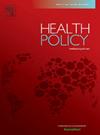Unveiling patterns and drivers of immigrant health integration policies: A model-based cluster and panel data analysis in MIPEX countries
IF 3.4
3区 医学
Q1 HEALTH CARE SCIENCES & SERVICES
引用次数: 0
Abstract
Background
The integration of immigrant health is a complex process with significant implications for both immigrants and host communities, yet the policies guiding such integration display considerable variation across nations and remain substantially underexplored. This study aims to examine the patterns of health integration policies across countries, identify their distinct characteristics, and investigate the drivers shaping these policies at a global scale.
Method
We analyzed data from the Migrant Integration Policy Index (MIPEX) using a cluster analysis of health integration policies in 56 countries. Publicly available international datasets on healthcare capacity, migration dynamics, and institutional development were integrated into a panel data analysis to explore the factors driving these policies.
Findings
The analysis identifies three distinct patterns of health integration policies: supportive, restrictive, and generalized. Key drivers include healthcare expenditure, migrant acceptance, and economic development, indicating the interplay of health system capacity, public attitudes, and institutional efficacy in shaping policy performance of immigrant health integration.
Conclusion
This research advances understanding of how health integration policies are structured globally and how migration dynamics, institutional factors, and healthcare capacity influence these policies. The findings offer insights into the policy environments that shape immigrant health integration and suggest policy recommendations to promote health equity.
揭示移民健康一体化政策的模式和驱动因素:MIPEX国家基于模型的集群和面板数据分析
移民健康一体化是一个复杂的过程,对移民和收容社区都有重大影响,但指导这种一体化的政策在各国之间表现出相当大的差异,而且仍未得到充分探索。本研究旨在检查各国卫生一体化政策的模式,确定其独特特征,并调查在全球范围内形成这些政策的驱动因素。方法对56个国家的卫生整合政策进行聚类分析,分析移民融合政策指数(MIPEX)的数据。关于医疗保健能力、移民动态和机构发展的公开国际数据集被整合到一个小组数据分析中,以探索推动这些政策的因素。分析确定了三种不同的卫生一体化政策模式:支持性、限制性和普遍化。主要驱动因素包括医疗保健支出、移民接受度和经济发展,这表明卫生系统能力、公众态度和制度效率在塑造移民健康整合政策绩效方面的相互作用。本研究促进了对全球卫生一体化政策如何构建以及移民动态、制度因素和卫生保健能力如何影响这些政策的理解。研究结果对影响移民健康融合的政策环境提供了见解,并提出了促进健康公平的政策建议。
本文章由计算机程序翻译,如有差异,请以英文原文为准。
求助全文
约1分钟内获得全文
求助全文
来源期刊

Health Policy
医学-卫生保健
CiteScore
6.40
自引率
6.10%
发文量
157
审稿时长
3-8 weeks
期刊介绍:
Health Policy is intended to be a vehicle for the exploration and discussion of health policy and health system issues and is aimed in particular at enhancing communication between health policy and system researchers, legislators, decision-makers and professionals concerned with developing, implementing, and analysing health policy, health systems and health care reforms, primarily in high-income countries outside the U.S.A.
 求助内容:
求助内容: 应助结果提醒方式:
应助结果提醒方式:


